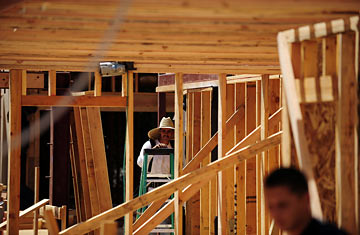
Construction workers build a new housing development in Los Angeles
What should we make of the housing market now? The past few days have seen a cascade of new data about house prices, home sales and troubled loans. The broad takeaway is that the market continues to steady. But behind the headline numbers are plenty of signs that the sector is still fragile — and that our housing-related troubles are far from definitively over.
The first batch of numbers instilling hope that we've arrived at a bottom shows that house prices are beginning to creep back up. The S&P/Case-Shiller index of home prices in 20 cities saw a 1.4% gain between May and June. That's only the second time the index has risen since the summer of 2006 (the other time was the month before). Once you adjust the data for seasonality — the fact that houses tend to sell for more money in the warmer months — the increase in July was actually the first since May 2006. Home-price data from the Federal Housing Finance Agency, which tracks homes with mortgages owed or guaranteed by Fannie Mae and Freddie Mac, also showed a May-to-June gain, of 0.5%.
This is good news for sure, but the data don't come without caveats. First of all, as economist Robert Shiller has pointed out, the index that bears his name has shown signs of turning a corner in the past. In early 2008, the rate of monthly home-price declines started dropping (that is, the housing situation looked to be moving from really bad to less bad). That momentum didn't stick, though, owing to the broader economic downturn. This time around, a first-time homebuyer tax credit is giving a huge boost to the market — nearly a third of buyers now fall into that camp. If the feds don't extend that tax credit when it sunsets at the end of November, will the current housing-recovery momentum peter? It's a great question with an unknowable answer.
Furthermore, just because house prices overall may be rebounding, that doesn't mean everyone benefits. Looking at the Case-Shiller data broken down by house price makes clear that the high end of the housing market is still in trouble. For low- and mid-tier houses — roughly, those costing less than $430,000 — prices in June rose between 2.3% and 2.6%. For more-expensive houses, prices nudged up just 0.7%.
The other number stirring up significant optimism about housing is the Commerce Department's measure of new-home sales. In July, for the fourth month in a row, the number of new homes sold, on a seasonally adjusted basis, rose. July's jump, of 9.6%, seems downright striking.
Data on new-home sales, though, are notoriously imprecise and volatile. The margin of error on July's 9.6% gain, for instance, is plus or minus 13.4%. In other words, strictly speaking, the Commerce Department can't be sure the figure didn't actually go down. For that reason, new-home sales are best looked at over five or six months. There's still reason for optimism: a four-month string of increases is starting to get to the point at which one can legitimately call the trend significant. That's especially true when overlaid with data from the National Association of Realtors that show sales of previously owned houses are going up too. Still, what happens with new-home sales in the next few months will be incredibly important context.
Even if house prices and sales are on the mend, that doesn't equate to a clean bill of health for housing overall, since woes in the mortgage sector continue to surface. Another number out this week was the delinquency rate among loans backed by the federal housing agency Freddie Mac. The number of people 90 or more days behind on their mortgages continues to rise — in July, 2.95% of Freddie Mac loans were late, up from 2.78% the month before, and 1.01% a year ago. Furthermore, a new study from the credit-rating agency Fitch found that among people falling behind on payments, fewer and fewer are able to catch up. Looking at a set of mortgages that had been bundled into securities, Fitch calculated that as of July, just 6.6% of delinquent borrowers with prime loans were catching back up on payments. Between 2000 and 2006, some 45% of such borrowers did.
One culprit, of course, is the economy. A person who has lost a job is going to have a tougher time making the mortgage payment. On top of that, a lot of the moratoriums on foreclosures that lenders put into place while the Obama Administration figured out its loan-rewrite program no longer exist. The foreclosure movie was on pause for a while, but that's no longer the case.
We're now moving forward, and even though it looks like we're doing that in a positive way, there could still be more plot twists ahead.
